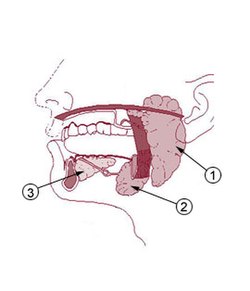Salivary gland

The salivary glands make saliva. Saliva keeps the mouth and other parts of the digestive system wet and slippery. It also helps break down food when you are chewing. This helps food go down the throat to the stomach.
There are three main pairs of salivary glands.[1] They are
- the parotid,
- the submandibular and
- the sublingual glands.
There are also many small glands in the tongue, cheeks, lips and palate. All of those glands make mucous.
Salivary secretions and structure
Saliva consists of two fluids, mucous and serous.
Mucous
Mucous (slime) is a saccharide glycoprotein called mucin. With water it makes the slippery lubricant used in many parts of the body, where it lines the moving parts, surfaces and tubes. Here it lubricates the mouth, throat and alimentary canal.
The mucous also has antiseptic qualities: it contains lysozyme and immunoglobulins. Mucous, with its antiseptic molecules and slime, traps fungi, bacteria and viruses and prevents infections. The body produces about a litre of mucous per day, in the mouth and other places.[2]
Serous Fluid
The serous fluid contains the enzyme amylase which acts in the digestion of carbohydrates. Minor salivary glands on the tongue secrete the amylase. The parotid gland produces purely serous saliva. The other major salivary glands produce mixed (serous and mucus) saliva.
Another type of serous fluid is secreted by the two layered serous membranes which line the body cavities. The serous fluid between the two layers acts as a lubricant and reduces friction from muscle movement.
Types of salivary gland
- The parotid gland makes serous secretion only.
- The submandibular glands are mixed glands. They give serous and mucous secretions.
- The sublingual glands make mucous only.
Structure of salivary glands
The glands are inside a capsule, of connective tissue. Inside, it is made of little parts called lobules. Blood vessels and nerves go into the lobules. There are three main types of cells in the major salivary glands:
- Serous cells are shaped like a pyramid. They are joined together in a group that is shaped like a ball.
- Mucous cells are usually shaped like a cube. They are joined together to make a tubules, which are very small tubes.
- Myoepithelial cells are all around the part of the gland where the saliva comes out. They can squeeze the saliva gland so the saliva comes out faster.
The small tubes go into ducts. Those ducts go into larger ducts that have little stripes on them, called striations. Those go into ducts between the lobes of the gland (called interlobar or excretory ducts). The main duct of the salivary glands then opens into the mouth.
Where the glands are
There are three salivary glands:
- The two parotid glands are near the ear (par- = next to, -otid = ear). They are the largest salivary glands.
- The sublingual gland is under the tongue.
- The submandibular gland is in the shape of a “U”. It is under the chin bone which is called the mandible.
Medical notes
- See mumps
Ducts can get blocked. This would cause pain and swelling of the gland.
Tumours of the salivary glands can occur. These are usually benign. Investigation is done by a sialogram, which is a radiocontrast study of a salivary duct.
Salivary Gland Media
Micrograph of chronic inflammation of the salivary gland sialadenitis)
References
- ↑ 1.0 1.1 Fehrenbach; Herring 2007. Illustrated head and neck anatomy. Elsevier. 170–171
- ↑ "What's a booger?". KidsHealth.
Other websites
- Salivary Gland Disorders Archived 2013-01-04 at Archive.today
- Illustration Archived 2005-12-07 at Archive.today
- Illustration Archived 2005-12-21 at Archive.today
- Photo Archived 2006-07-19 at the Wayback Machine
- eMedicine
